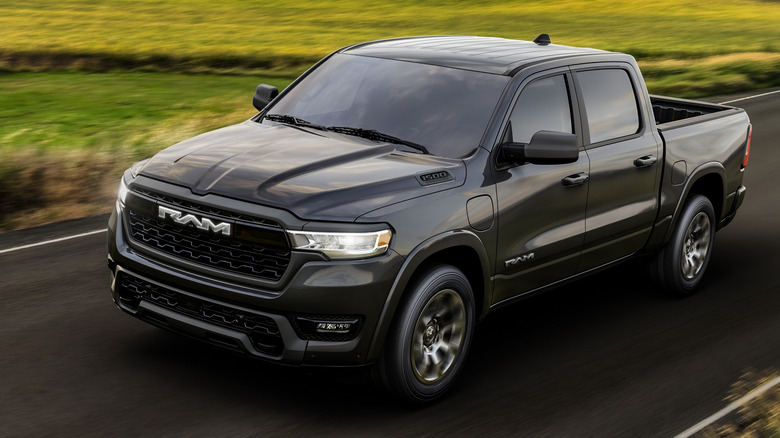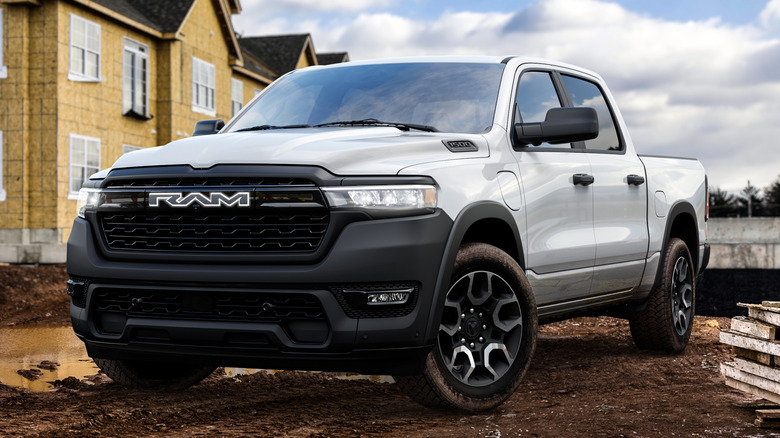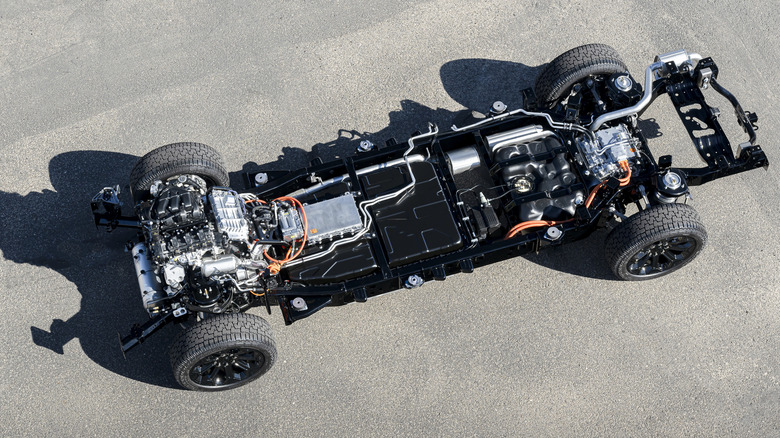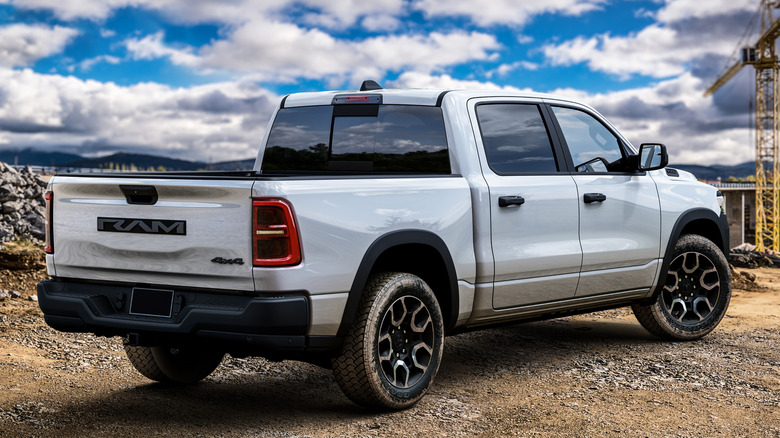The Ramcharger's Unusual Electric Setup Makes More Sense Than You'd Think: Here's Why
Today, Stellantis revealed the 2025 Ram 1500 Ramcharger and it is, in technical terms, really weird. Ram is still on its way to make the fully electric Ram REV 1500 a reality, but it'll coexist with — rather than replace — the Ramcharger in Stellantis' alternative energy pickup range. The current Ford F-150 Lightning, upcoming Chevy Silverado EV, and the GMC Hummer pickup are all fairly standard EVs, and the REV 1500 will more or less follow that trend: A big battery that powers electric motors, like every other EV.
The Ramcharger is something else entirely. It may seem at first glance like a plug-in hybrid, in that it has electric motors and a battery working in concert with a gasoline engine. But it isn't like a Chevy Volt or Toyota Prius Prime, because there's no mechanical connection between the electric motors and the gas engine.
The Ramcharger instead uses a 3.6-liter V6 (likely similar if not identical to the engine in the Jeep Wrangler and many other Stellantis products) to spin up the generator, which feeds electrical power to its electric motors. The closest equivalent we may have today is a diesel electric locomotive, which relies on a large diesel generator to send electrical power to electric traction motors. Given the fact the Ramcharger is also a large body-on-frame American truck with a battery under the floor, it's likely similar to a locomotive in weight as well. It's worth noting that this technology that Stellantis is using has been around for about a century.
Weird is Chrysler's bread and butter
While Ford and General Motors are duking it out over electric truck supremacy (with Rivian and Tesla cheering on the sidelines), Stellantis is doing its own thing entirely with the Ramcharger. Looking in the back catalog of brands like Dodge, that's really par for the course.
Way back in 2015, when other automakers were scrambling to get hybrids out and cleanup their environmental image, Dodge threw all logic and reason right into the Detroit River and came up with the Dodge Charger and Dodge Challenger SRT Hellcat, two cars with more horsepower than some Lamborghinis that could only achieve double digit miles per gallon if they were rolling downhill. Suffice to say, Stellantis (specifically its Chrysler-derived divisions) is perfectly content going against the flow.
In today's climate, that contrary thinking may be exactly what Stellantis needs. The current electric vehicle market is a bit of a mess: In an effort to be more futuristic and beat Tesla, every automaker made weird, space egg-shaped EVs. Ford and Acura subsequently made waves by making the F-150 Lightning and upcoming ZDX SUV look like normal cars. Doing something different gets you noticed, even if that means using wacky old technology or not making a full-EV.
Better than the competition
Specs-wise, the Ramcharger may end up taking the cake compared to the F-150 Lightning and Silverado EV, at least when you consider truck-based duties like towing capacity and payload. The F-150 Lightning has a maximum payload of 2,235 pounds. The Silverado EV falls flat on its face with a maximum payload of only 1,300 pounds. Ram, in contrast, says the Ramcharger should be able to carry up to 2,625 pounds, making it by far the best vehicle in the segment when it comes to, y'know, actually using it like a truck.
As for towing a trailer, both the Lightning and the Silverado EV can muster 10,000 pounds of capacity. The Ramcharger will max out at 14,000 pounds, Ram promises, making it more of an actual truck and not simply a lifestyle vehicle to flex on everyone.
In short, there's a solid argument that the Ramcharger gets the best of both the EV and gasoline worlds. The electric motors give it plenty of torque (615 pound-feet) to pull loads with, yet the onboard generator allows it to keep going hundreds of miles after an EV's battery would die out. After all, even if the F-150 Lightning could tow as much as the Ramcharger, EVs and pulling heavy loads don't exactly mix well and the batteries have the tendency to run out of range much more quickly.
Can Ram pull it off?
It's important to make it clear that — though it has a plug, as well combining two power sources — the Ramcharger is not a conventional plug-in hybrid, but it could well benefit from that same strategy of being more than the sum of your parts. PHEVs are able to (almost) combine the best of both the EV and gasoline world into one coherent vehicle. The Ramcharger does that too, only in its own, very Chrysler-like way.
Provided the fact that no one outside of Stellantis has driven it yet, it's tough to know for sure, but it looks like it could be a type of truck with no significant downsides. It can pair the efficiency, power, relative environmental friendliness of electric motors with the convenience and usability of gasoline power. We still have to wait a year or two to know for sure, with production not expected to kick off until late 2025.
Given the Ramcharger's specifications on paper, though, it could be a real winner, provided Ram is actually able to make the truck in significant numbers to matter. If Ford's troubles with the F-150 Lightning and GM's overall lackluster performance with the Ultium platform give us any lessons, building an alternatively powered truck is not always a straightforward process.



